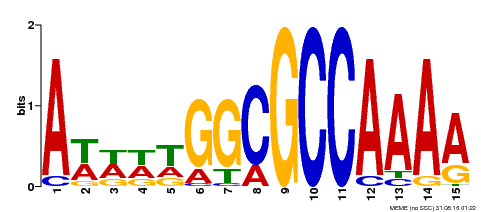| Signature Domain? help Back to Top |
 |
| No. |
Domain |
Score |
E-value |
Start |
End |
HMM Start |
HMM End |
| 1 | E2F_TDP | 85 | 5.8e-27 | 155 | 220 | 1 | 71 |
E2F_TDP 1 rkeksLrlltqkflkllekseegivtlnevakeLvsedvknkrRRiYDilNVLealnliekkekneirwkg 71
r+++sL+llt+kf+kl++++e+g+++ln +a L +v ++RRiYDi+NVLe+++liek+ kn+irwkg
AT1G47870.1 155 RYDSSLGLLTKKFVKLIQEAEDGTLDLNYCAVVL---EV--QKRRIYDITNVLEGIGLIEKTTKNHIRWKG 220
6899******************************...99..****************************98 PP
|
| Publications
? help Back to Top |
- Riechmann JL, et al.
Arabidopsis transcription factors: genome-wide comparative analysis among eukaryotes.
Science, 2000. 290(5499): p. 2105-10
[PMID:11118137] - de Jager SM,Menges M,Bauer UM,Murra JA
Arabidopsis E2F1 binds a sequence present in the promoter of S-phase-regulated gene AtCDC6 and is a member of a multigene family with differential activities.
Plant Mol. Biol., 2001. 47(4): p. 555-68
[PMID:11669580] - Mariconti L, et al.
The E2F family of transcription factors from Arabidopsis thaliana. Novel and conserved components of the retinoblastoma/E2F pathway in plants.
J. Biol. Chem., 2002. 277(12): p. 9911-9
[PMID:11786543] - Kosugi S,Ohashi Y
Interaction of the Arabidopsis E2F and DP proteins confers their concomitant nuclear translocation and transactivation.
Plant Physiol., 2002. 128(3): p. 833-43
[PMID:11891240] - Vandepoele K, et al.
Genome-wide analysis of core cell cycle genes in Arabidopsis.
Plant Cell, 2002. 14(4): p. 903-16
[PMID:11971144] - del Pozo JC,Boniotti MB,Gutierrez C
Arabidopsis E2Fc functions in cell division and is degraded by the ubiquitin-SCF(AtSKP2) pathway in response to light.
Plant Cell, 2002. 14(12): p. 3057-71
[PMID:12468727] - Yamada K, et al.
Empirical analysis of transcriptional activity in the Arabidopsis genome.
Science, 2003. 302(5646): p. 842-6
[PMID:14593172] - Koroleva OA,Tomlinson ML,Leader D,Shaw P,Doonan JH
High-throughput protein localization in Arabidopsis using Agrobacterium-mediated transient expression of GFP-ORF fusions.
Plant J., 2005. 41(1): p. 162-74
[PMID:15610358] - del Pozo JC,Diaz-Trivino S,Cisneros N,Gutierrez C
The balance between cell division and endoreplication depends on E2FC-DPB, transcription factors regulated by the ubiquitin-SCFSKP2A pathway in Arabidopsis.
Plant Cell, 2006. 18(9): p. 2224-35
[PMID:16920782] - Jurado S, et al.
SKP2A, an F-box protein that regulates cell division, is degraded via the ubiquitin pathway.
Plant J., 2008. 53(5): p. 828-41
[PMID:18036202] - L
Distinct light-initiated gene expression and cell cycle programs in the shoot apex and cotyledons of Arabidopsis.
Plant Cell, 2008. 20(4): p. 947-68
[PMID:18424613] - de Jager SM, et al.
Dissecting regulatory pathways of G1/S control in Arabidopsis: common and distinct targets of CYCD3;1, E2Fa and E2Fc.
Plant Mol. Biol., 2009. 71(4-5): p. 345-65
[PMID:19662336] - Sozzani R, et al.
The E2FD/DEL2 factor is a component of a regulatory network controlling cell proliferation and development in Arabidopsis.
Plant Mol. Biol., 2010. 72(4-5): p. 381-95
[PMID:19937368] - Boruc J, et al.
Functional modules in the Arabidopsis core cell cycle binary protein-protein interaction network.
Plant Cell, 2010. 22(4): p. 1264-80
[PMID:20407024] - Van Leene J, et al.
Targeted interactomics reveals a complex core cell cycle machinery in Arabidopsis thaliana.
Mol. Syst. Biol., 2010. 6: p. 397
[PMID:20706207] - Jurado S, et al.
The Arabidopsis cell cycle F-box protein SKP2A binds to auxin.
Plant Cell, 2010. 22(12): p. 3891-904
[PMID:21139066] - Heckmann S, et al.
The E2F transcription factor family regulates CENH3 expression in Arabidopsis thaliana.
Plant J., 2011. 68(4): p. 646-56
[PMID:21771121] - Berckmans B, et al.
Light-dependent regulation of DEL1 is determined by the antagonistic action of E2Fb and E2Fc.
Plant Physiol., 2011. 157(3): p. 1440-51
[PMID:21908689] - Hirano H,Shinmyo A,Sekine M
Both negative and positive G1 cell cycle regulators undergo proteasome-dependent degradation during sucrose starvation in Arabidopsis.
Plant Signal Behav, 2011. 6(9): p. 1394-6
[PMID:22019639] - Gaudinier A, et al.
Enhanced Y1H assays for Arabidopsis.
Nat. Methods, 2011. 8(12): p. 1053-5
[PMID:22037706] - Cruz-Ram
A bistable circuit involving SCARECROW-RETINOBLASTOMA integrates cues to inform asymmetric stem cell division.
Cell, 2012. 150(5): p. 1002-15
[PMID:22921914] - Jin J, et al.
An Arabidopsis Transcriptional Regulatory Map Reveals Distinct Functional and Evolutionary Features of Novel Transcription Factors.
Mol. Biol. Evol., 2015. 32(7): p. 1767-73
[PMID:25750178] - Kobayashi K, et al.
Transcriptional repression by MYB3R proteins regulates plant organ growth.
EMBO J., 2015. 34(15): p. 1992-2007
[PMID:26069325] - Li B, et al.
Network-Guided Discovery of Extensive Epistasis between Transcription Factors Involved in Aliphatic Glucosinolate Biosynthesis.
Plant Cell, 2018. 30(1): p. 178-195
[PMID:29317470] - Huntley R, et al.
The maize retinoblastoma protein homologue ZmRb-1 is regulated during leaf development and displays conserved interactions with G1/S regulators and plant cyclin D (CycD) proteins.
Plant Mol. Biol., 1998. 37(1): p. 155-69
[PMID:9620273]
|





